|
Cruel April
April is the cruellest month – the opening of Eliot’s The Waste Land (Part 1: Burial of the
Dead) – seems sadly very apt this year as it saw the funeral of Philip Kerr and
a memorial service for Colin Dexter, who died last year.
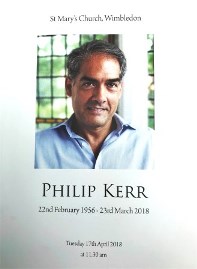 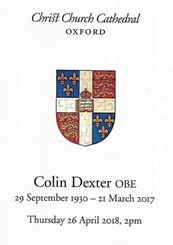
I
met Philip and Colin at roughly the same time in 1990 on the fringes of
Bouchercon XXI in London, the first Bouchercon crime convention to be held
outside the USA and possibly the only one ever held at a venue without a bar.
Over
the years I have had the great pleasure in reviewing the novels of both, for
the Daily Telegraph and the Birmingham Post, and have the
distinction of being reviewed by both Philip and Colin. In Time Out, Philip reviewed my 1991 novel Angels in Arms, opening
with a description it took me some time to live down: ‘Physically, Mike Ripley resembles the Irish police captain who always
gets it wrong. But his writing is faultless, and the funniest thing about
Ripley is his novels…Comic crime writing isn’t easy, but Ripley’s Angel novels
are as witty as they are deftly plotted.’
And
in 2005, Colin was asked to review my historical thriller Boudica and the Lost Roman
for the Birmingham Post, graciously
noting the jokes (even more graciously ignoring the mistakes in my Latin) and
judging that the novel showed ‘insight,
compassion and considerable scholarship’. (After that appeared I asked the editor of the
paper if I could have the hand-written review Colin had submitted as a
souvenir. I was told it had been ‘recycled’.)
Colin’s
Memorial Service, held in Christ Church Cathedral, Oxford, was an inspiring
event, with eulogies from Philip Pullman, Kevin (‘Lewis’) Whately, Val
McDermid, members of the A.E. Houseman Society and numerous crossword experts.
I rather dauntingly found myself in the choir pews sitting next to the
crossword editor of The Times, but
relaxed at the civic reception which followed the service in the company of,
among others, Inspector Morse producer
Ted Childs, crime writer Michael Jecks and Hilary Hale, Colin’s editor back in
1990 who introduced the two of us, therefore bearing an awesome responsibility…

Looking
down on us as we remembered him, was Colin’s portrait by artist Celia Montague,
which I had not seen before. I also learned that during his National Service in
the army’s Signal Corps in 1948-49, Colin became a high-speed Morse operator.
Books of the Month
I
am tempted to use the old reviewer’s cliché that a plot has been ‘ripped from
the headlines’ when recommending Firefly by Henry Porter, published
this month by Quercus.
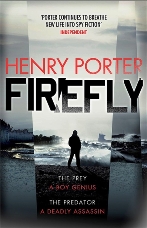
Technically,
I suppose, the news cycle has moved on to the recent horrific chemical attacks
in Syria, but the sad, underlying story of Syrian refugees fleeing into Europe
should never be allowed to drop off the news agenda. It is actually within this
chaotic stream of refugees flooding from Turkey to Greece, Macedonia and
Serbia, that Henry Porter sets his story. A young, intelligent Syrian boy
carrying a phone on which there is damning evidence of ISIS atrocities, sets
off in advance of his family to try and reach the safety of Germany, ducking
and diving along the way to dodge the perils which face him at every stage of
his journey. Not only does he have to avoid people smugglers, thieves, child
molesters and border police but he might just have an ISIS terrorist cell
hunting him. Help, if they can find each other in the Balkan mountains, is on
hand in the shape of Luc Samson, a freelance intelligence agent with a personal
refugee past and an unusual second occupation as a successful gambler on
horse-racing.
The
boy’s desperate journey and the people he meets along the way, coupled with
Sampson’s hunt for him using every play in the modern spy’s training manual,
make for a total enthralling story told with pace and compassion.
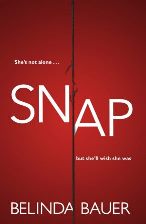
As
something of a squeamish soul who normally avoids crime novels which feature
vulnerable children and pregnant women, I was unsure how I would react to Snap,
the new novel published by Bantam, from
the award-winning Belinda Bauer, as it contains a family of three of the former
and two of the latter; one whose murder is the prologue of the book and the other
who is in jeopardy from the start.
Told
initially as parallel narratives seemingly unconnected, the two streams
converge into a gripping narrative thanks to Bauer’s clear, unfussy prose and a
sharply observant eye. This is superior British noir (only in Britain would the police screw up a stake-out in such
a way) in a domestic setting and is a thriller worthy of sharing a title used
back in 1974, when Belinda Bauer was still at school, for another suspenseful
slice of domestic crime and punishment.
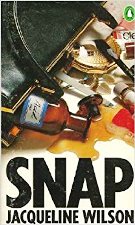
Yes,
that Jaqueline Wilson whose early
published work included four excellent psychological thrillers before she
switched to children’s fiction. I wonder how she got on after turning her back
on crime fiction…
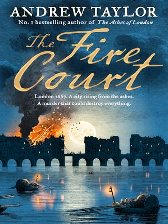
With
an Andrew Taylor historical mystery, the reader is guaranteed good history,
good mystery and very good writing. The Fire Court, from HarperCollins,
delivers on all fronts with a multi-threaded plot centred on the Fire Court
established after the 1666 Great Fire to adjudicate on re-building rights in a
London parts of which resemble, thanks to some brilliant writing, a cross
between the Blitz and downtown Aleppo.
In
a devastated city, the rebuilding contracts could be a rich prize, though who
would have thought town planning and civic governance might be corrupt? To keep
an eye on proceedings (or at least try to), Taylor employs James Marwood, as do
several interested parties, and who suffers a violent disfigurement in the
process. Another character from Taylor’s best-selling The Ashes of London is
the enigmatic ‘Cat’ - an intelligent woman who realises her dream of becoming
an architect will never be fulfilled because she is (a) the daughter of a
regicide and (b) female.
There
is a satisfyingly gruesome murder by fire bomb and a running motif of the
casual violence meted out to women and servants in a world dominated by strong
beliefs in heaven, hell and redemption mixed with guilty feelings about having
killed one king and restored another. Andrew Taylor conjures that world
brilliantly, though in the process makes one very grateful for the twin modern
blessings of sanitation and antibiotics.
The
Fire Court stands
alone but for maximum enjoyment I strongly recommend reading The Ashes
of London first.
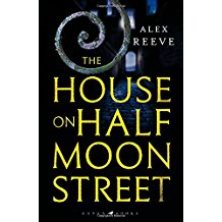
Alex
Reeve has set the bar high for his entry into crime fiction, for not only is
his chosen setting a Victorian one – London of 1880 – which has been regularly
visited by crime writers since Conan Doyle fired the starting gun, but he has
as his protagonist a young man who is actually a young woman, trapped in the
wrong body. In The House on Half Moon Street, from Raven Books, life for
chess-playing mortuary attendant Leo (who was born Charlotte) gets even more
complicated when the love of his life Maria, a working girl in the brothel of
the title, is found dead and Leo is initially the prime suspect – at least
according to the fearsome Detective Sergeant Ripley (who surely deserves a
spin-off series). The physical problems of being a woman masquerading as a man,
especially when visiting a brothel or when incarcerated in an all-male prison
cell with only a crude shared toilet are not glossed over. In fact, there may
be too much detail for the more sensitive reader and there is the problem that
Leo, with so much to hide and being sweetly innocent on so many things, is not
convincingly equipped for the role of detective he adopts although he seems to
have unlimited funds when it comes to hiring cabs. Still, Alex Reeve
confidently sets a cracking narrative pace and maintains it as his hero/heroine
comes up against the brick wall of Victorian social privilege.
{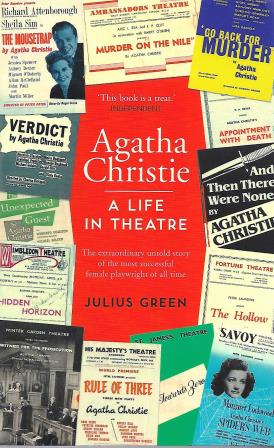
If
you ever wanted to know anything – and by ‘anything’ I mean everything – about Agatha Christie’s
work in the theatre, then Agatha Christie A Life in the Theatre
by Julius Green is as good as a ticket in the front stalls. Now a superbly
illustrated paper from HarperCollins, which shows just how far paperback
production values have come, Green’s surely definitive work will answer any
question and (Spoiler Alert!) might just provide some questions for a certain
quiz at this month’s Crimefest.
Forbidden Books of the Month
For
legal reasons I can tell you nothing about the new James Bond novel Forever
and a Day by Anthony Horowitz, which I am really looking forward to
having thoroughly enjoyed his previous outing in the Bond continuation
franchise, Trigger Mortis.
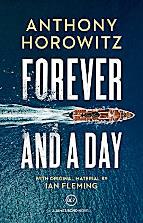
All
I can say is that the book is due to be published on 31st May and
will be, I am told, the fortieth official James Bond novel.
I
know even less about John Lawton’s latest novel Friends and Traitors
despite being a long-time fan of John’s historical spy thrillers featuring the
Troy dynasty and just about every real shady political figure in the 20th
century.
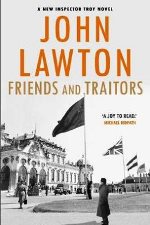
I
am reliably informed that the book was published last month and has even been
reviewed in Shots though it has been
studiously kept off my radar. It looks like I will have to buy a bloody copy at
Crimefest, where John is one of the
most eagerly anticipated speakers.
One
new book I am not allowed to mention because of a strict embargo until
publication on 22nd May, is Stephen King’s The Outsider from Hodder
and Stoughton.
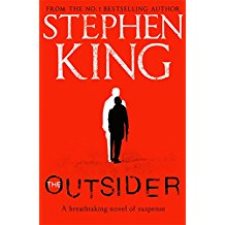
As I always do what I am told by publishers, I will
say no more other than to hazard a guess as to what will be the #1 bestseller
on 23rd May.
Nordic Lightly Noir
To
coincide with is new novel Holy Ceremony from Bitter Lemon,
Finnish crime writer Harri Nykänen attempts to convince us that Finland can
offer the reader the lighter side of Nordic Noir.
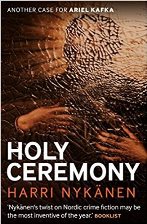
In
an essay on the Crime Reads website (http://crimereads.com/finland-the-lighter-side-of-nordic-noir/) the creator of Ariel Kafka, one of
the few (if not only) Jewish policemen in Helsinki, does his best to soften the
stereotypical view of his fellow Finns, though perhaps not in a way of which
the Finnish Tourist Board (I am sure there must be one) would approve.
For
example, Harri claims that when it comes to suicide rates, Finland aims to be
the ‘top nation worldwide, easily beating all of Scandinavia’ and takes a wry
pride in the old legend that his country spawned ‘the unholy trinity of hard
liquor, a knife and a Finn’.
Nordic Lightly Noir
To
coincide with is new novel Holy Ceremony from Bitter Lemon,
Finnish crime writer Harri Nykänen attempts to convince us that Finland can
offer the reader the lighter side of Nordic Noir.

In an essay on the Crime Reads website (http://crimereads.com/finland-the-lighter-side-of-nordic-noir/) the creator of Ariel Kafka, one of the few (if not only) Jewish policemen in Helsinki, does his best to soften the stereotypical view of his fellow Finns, though perhaps not in a way of which the Finnish Tourist Board (I am sure there must be one) would approve.
For example, Harri claims that when it comes to suicide rates, Finland aims to be the ‘top nation worldwide, easily beating all of Scandinavia’ and takes a wry pride in the old legend that his country spawned ‘the unholy trinity of hard liquor, a knife and a Finn’.
|
|
Live Now, Read Later
When
I was young and innocent and prone to wandering through forest glades and
fields of daffodils reciting those immortal lines Hello trees, Hello flowers, I remember being warned not to read a
rather risqué novel Live Now Pay Later by Jack Trevor Story.
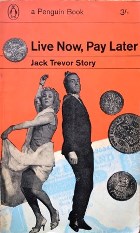
I
was never sure why I was warned against the book – presumably it promoted ‘fast
living’ – and I actually did manage to avoid reading it although there was a
time when its Penguin film tie-in edition seemed to be absolutely everywhere in
the Swinging Sixties.
I
had no idea until recently that Jack Trevor Story (1917-1991) had also tried
his hand at genre fiction with Westerns and thrillers in the long-running
‘Sexton Blake’ series, which I also managed to avoid with consummate ease just as
I have all the hundreds(?) of other ‘Sexton Blake’ stories.
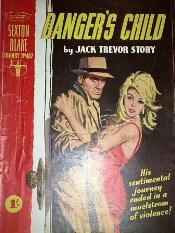 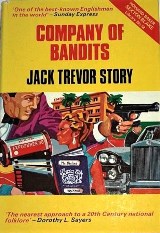
Clearly
created in a wave of Sherlockian mania, London private detective Sexton Blake
made his first fictional appearance in 1893 and went on to appear in comic
strips, magazine serials, novels and even a television series into the1970s. It
has been estimated that in total, there have been 176 ‘Blake’ authors. Many of
the stories were churned out by stables of agency writers often sharing the
same ‘house’ pen names – or perhaps it was one writer or editor using a lot of
pen-names. Such things were far from unknown in the history of British pulp
paperbacks, nor was the recycling of plots or even entire novels, republished
with a different title or different hero in the hope not even the most
dedicated Sexton Blake fan would notice. (This recycling of previously
published novels was known in the trade as ‘de-Blake-ing’.)
One
of the stalwarts behind the Sexton Blake ‘industry’ was journalist turned
author turned editor and eventually publisher, W. Howard Baker (1925-1991) who
licensed the Sexton Blake brand when it was dropped by the magazine company
Fleetway Publications in 1963. Baker revived the Sexton Blake Library where
readers could receive 24 books by post ‘to any address in the world’ for an
annual subscription of 96/- (ninety-six shillings or £4.80, as was).
This
‘Fifth Series’ of the library included The Company of Bandits (1965) by
Jack Trevor Story, four titles by ‘W.A. Ballinger’ and one by ‘Peter Saxon’
(both pen-names of Howard Baker) and two by W. Howard Baker himself, including Every
Man An Enemy.
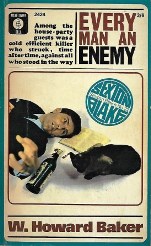
Published in 1966, Every Man An Enemy is a
‘revised and enlarged’ edition of Baker’s novel Walk in Fear from 1957, and
to be honest, is far more interesting and funnier, when it doesn’t feature
private detective (should that be ‘consulting detective’?) Sexton Blake who
eventually makes an appearance half-way through. The plot involves the
manuscript of a potential best-selling novel delivered anonymously to a seedy
agent wonderfully described as ‘a parasitic growth on the publishing world’ and
‘a literary spiv’ who operates out of an office above a Chinese laundry on the
Tottenham Court Road.
The agent immediately sells the book to
an eccentric publisher (a mad ex-Spitfire ace) and then realises he doesn’t
know who the anonymous author, pen-name MacDonald Hall, is or how to find him –
or her (spoiler alert!). To help get his grubby paws on the sizeable advance
offered, or at least his agent’s percentage, the agent gets help from a wily
Fleet Street journalist – another wonderfully seedy character – and finally
Sexton Blake, aided briefly by his side-kick Tinker and hardly at all by his
pet bloodhound Pedro.
When five ‘authors’ turn up all
claiming to be MacDonald Hall, the action hots up and the plot thins visibly
when the murders start to happen, so naturally all concerned gather at the
publisher’s country mansion for Christmas (as you do) and things are sorted out
at rather a frantic pace.
Blasts from the Past
There
should probably be a special place in the history of British thrillerdom for
Kenneth Royce’s 1970 novel The XYY Man. Not only was it Royce’s
best-known book (he wrote some 40 novels) and was acclaimed by Dame Ngaio Marsh,
no less, as ‘a brilliantly sustained thriller’, it was turned into a very
popular television series, and not one, but two, spin-off series; all the time
being based on a totally spurious premise.
The
anti-hero of The XYY Man is Spider Scott, a professional cat burglar so good
at his job that British Intelligence is happy to sub-contract some very
dangerous, not to say illegal, tasks to him. Why ex-con ‘Spider’ is such a good
recruit for anything dodgy is because he is blessed, or cursed, with an extra
male ‘Y’ chromosome; hence ‘XYY’. This genetic bonus pre-disposes the carrier
to a life of anti-social behaviour and crime, which was indeed a popular theory
in the late 1960s despite the fact that there was absolutely no scientific
backing for it.
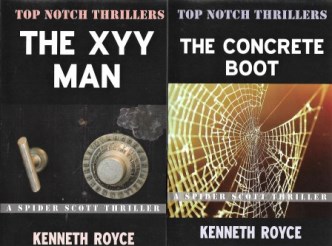
The
first two Spider Scott thrillers, from 1970 and 1971, are now reissued as Top
Notch Thrillers by Ostara Publishing (www.ostarapublishing.co.uk) as trade paperbacks and eBooks,
reviving the ‘XYY Man’ after being out-of-print for more than 20 years.
Supposedly
based on a real cat burglar whom he met whilst a prison visitor, Kenneth Royce
(1920-1997) turned ‘Spider’ Scott into one of the most popular anti-heroes on
television in 1976. Yet it was Spider’s nemesis in the novels, the dubious
Detective Sergeant Alf Bulman, who was, ironically, to have the longer career
on the small screen, appearing as a character in the 1978 series Strangers and then in his own spin-off
series (as a private eye) in Bulman in
1985.
I’ve Never Seen Star Wars
Well
of course that’s ridiculous; I’ve seen all the Star Wars movies. Indeed, in 1977 before the film was released
here, I was involved in a feature for BBC Look East explaining, with the help
of the Physics Department of Essex University, how lasers could be used as
weapons in space, illustrated by bits of the trailer from the forthcoming film.
But
I must admit I never saw The Wire, even
though I was well aware of it and was a great fan of David Simon’s Homicide, both the book and the
television series. However, I can now fill in a crucial gap in my knowledge by
reading All the Pieces Matter a lively, very readable oral history of
the series by Jonathan Abrams, out later this month from No Exit Press.
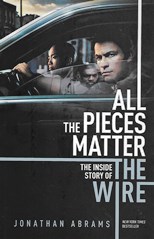
When The Wire was
first broadcast, I had legitimate medical reasons for not watching it. Abrams’
book makes me wish I had. Oh, if only there were some way of electronically
recording television programmes for later viewing, or some facility for
‘catching up’ on programmes missed… I am sure the technology is not beyond the
wit of man, although it can be confusing to those of us who are elderly and
infirm. For example, I have only just realised that ITV2+1 is not actually ITV
3.
But
then I am so old I remember having to get up from one’s seat, walk across a room
and turn a knob in order to change channels (as fantastical as that sounds
now). Fortunately, here at Ripster Hall, there are under-butlers employed
solely to carry out that task.
Mapping Spenser
My
first encounter with Robert B. Parker’s smart-talking Boston private eye the
monomynous Spenser was in 1982 when, as a subscriber to the Keyhole Crime
imprint, I obtained Looking For Rachel Wallace.
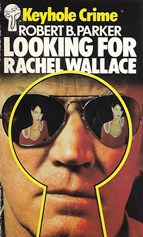
Keyhole
was a book club of sorts (run, I think, by Mills & Boon) where one bought
four paperbacks a month at reduced price. As one didn’t get a choice in which
four titles came through the post each month, many of the Keyhole paperbacks
came as a surprise. Some of them, a pleasant surprise as it was via Keyhole
that I discovered writers such as Simon Brett, Margaret Miller and Robert
Barnard.
Robert
B. Parker was a particular gem and I hastily tracked down other Spenser titles,
in those days published by Penguin. I remember being quite distraught when
Penguin, for some reason, dropped Parker and then delighted when I heard that
No Exit Press had picked up his back list. Today, No Exit still keep faith with
Spenser by publishing the novels by ‘continuation author’ Ace Atkins.
The
latest, possibly the 46th if my arithmetic holds up, Little White Lies, is out
now and comes, as all good detective novels used to, with a map – of Spenser’s
native Boston, of course.
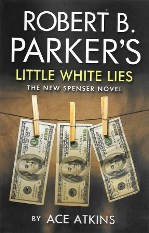
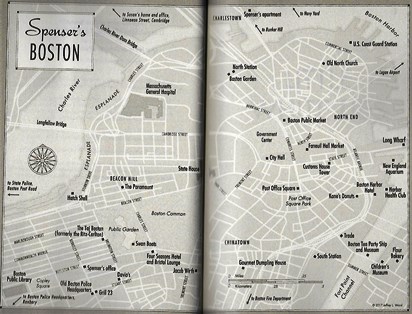
All Our Yesterdays
Inspired
by the television programme which looked back over world events twenty-five
years earlier (and which was last broadcast twenty-nine years ago) I have been
rootling through my archives to see what I was reviewing for that once-great
newspaper the Daily Telegraph in the
Spring of 1993.
The
pick of my ‘Crime Guide’ was Hard Aground by that ‘poet of the
hardboiled’ (and he is a poet) James Hall. At the time, James Hall’s
Florida-based crime novels were some of the most eagerly-anticipated fiction
from the other side of the Atlantic. Hall, an academic whose students included
Dennis Lehane, has sadly dropped off the radar, at least in the UK and I
believe his latest thrillers have yet to find a British publisher.
‘Crime’
and ‘Florida’ immediately suggest Carl Hiaasen and by 1993 he was established
enough for his backlist to be raided for early works not previously published
here. Written in partnership with fellow journalist William Montalbano, Powder
Burn and Trap Line appeared as paperbacks and while they might not have
enhanced, they certainly did not diminish the reputation of Hiaasen as the king
of comedy crime.
Another
of my American picks was In A Pig’s Eye by Robert Campbell,
‘an unusual, fresh, observant and intelligent’ look at streetwise crime and Democratic
party politics in Chicago. But then I was always a fan of Robert Campbell
(1927-2000) who, back in 1975, as R. Wright Campbell had written the stunning
WWI thriller The Spy Who Sat and Waited now, sadly, something of a forgotten
masterpiece of both historical crime and spy fiction.
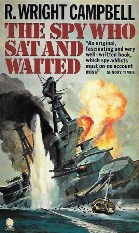
Flying
the flag for the home nations, and certainly holding their own against a wave
of classy American invaders, were Mark Timlin with Falls the Shadow, the
eighth of his Sarf London Nick Sharman thrillers; Philip Loraine (aka Robin
Estridge, 1920-2002) with Crackpot; Lesley Grant-Adamson with
her elegant Euro-thriller The Dangerous Edge; and a very
impressive debut, Night’s Black Agents, by David Armstrong, who was later to
write the wry and acerbic ‘self-help’ books How
Not To Write A Novel.
It
was an interesting and satisfying start to the crime fiction scene of 1993,
with not a Nordic, nor a Domestic, Noir in sight.
Straying from the Straight and Narrow
When
I stray from the path of crime fiction as I occasionally do, it is usually into
the world of non-fiction, and invariably into the fields of history and
archaeology. I have, however, been tempted out of my comfort zone by Posing
for Picasso by Sam Stone (Word Fire Press).
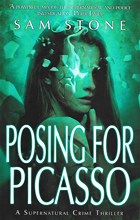
Sam
Stone is an established author of fantasy and horror fiction (and I crave her
indulgence if my terminology is incorrect) but in Posing for Picasso she
has produced an intriguing ‘mash up’ - as
I believe the young people call it - of
horror, the supernatural and the detective novel with more than a fair
sprinkling of art appreciation thrown in for good measure, creating a very
spooky cocktail indeed.
But
do not take just my word for it. The book comes with advance praise from Paul
Finch (the noted crime and horror writer), Ken Bruen (that consummate authority
on Celtic noir) and best-selling crime writer Peter James.
One reason to get Carter
My
mention of the prolific Australian pulpster Carter Brown has resulted in
several confessions from male readers of a certain age that they only bought
Carter Brown books ‘for their covers’. I have no idea why Where Did Charity Go? of
one of his Rick Holman, Hollywood private eye, novels from 1970 would have been
popular.
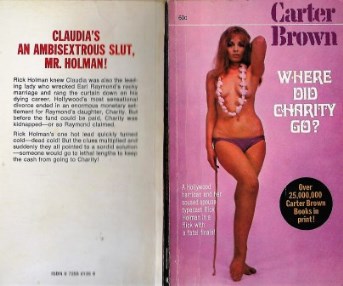
Unless,
of course, it was due to the flamboyant cover copy which announces, on the
back, that Claudia’s An Ambisextrous
Slut, Mr Holman! And on the front: A Hollywood harridan and her soused spouse
typecast Rick Holman in a flick with a fatal finale!
Who
could possibly resist blurbage as colourful as that?
See
You at Crimefest,
(not
if I see you first),
The
Ripster.
|